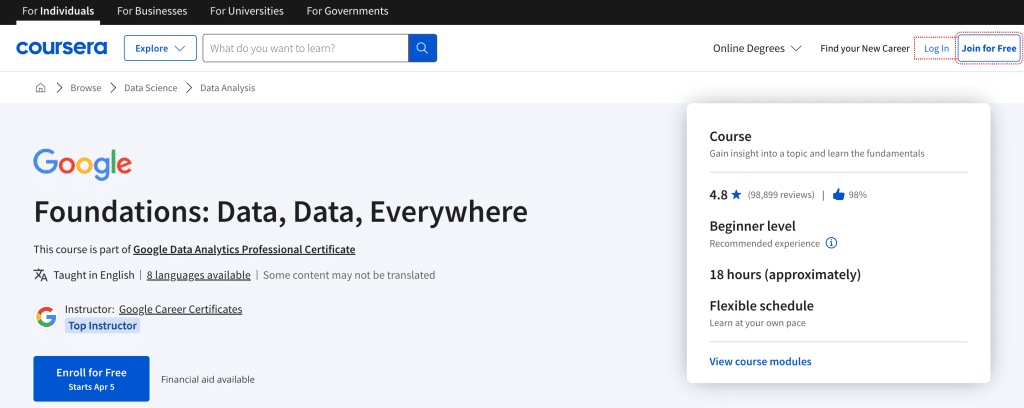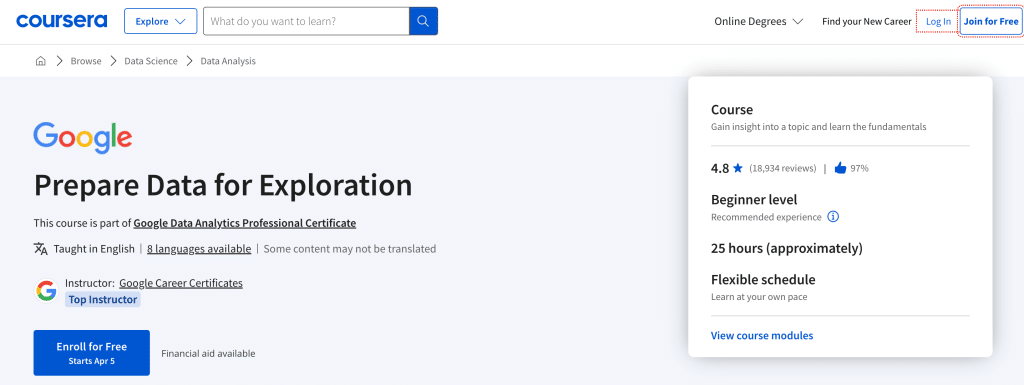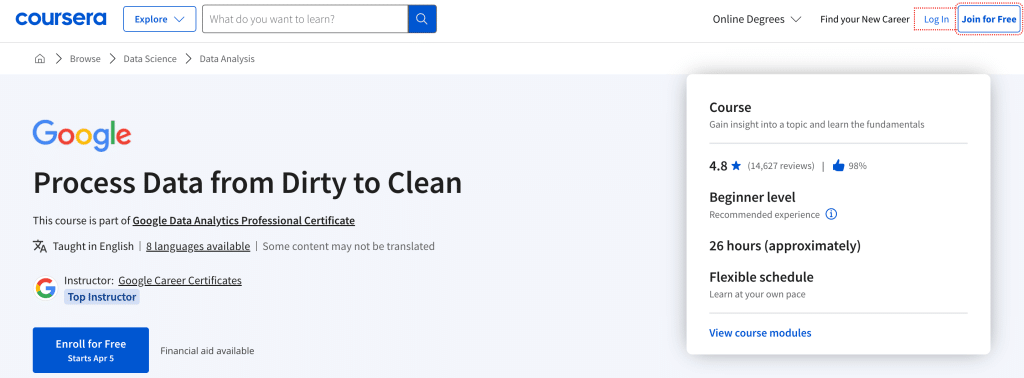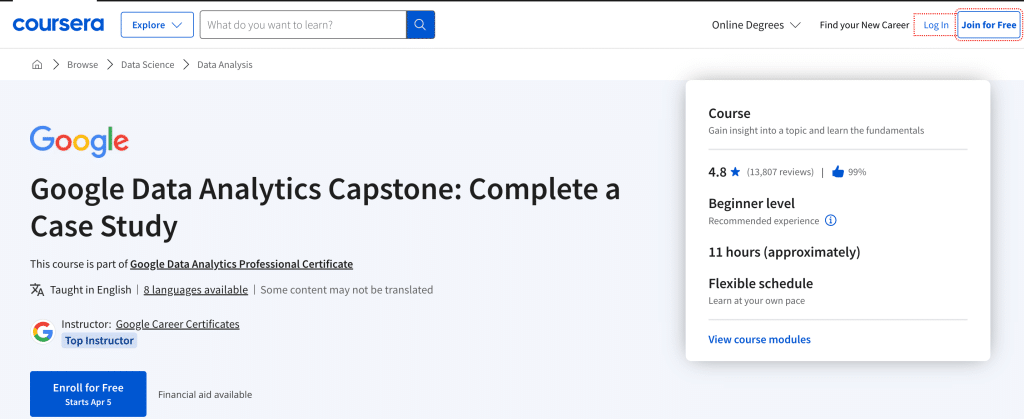I recently finished the Google Data Analytics Certification course on Coursera. I now understand its popularity and importance, so let me help you understand the same.
Full disclosure: I am a complete novice in data analytics, so this review is from the point of view of a newbie starting her journey in data analytics.
I also spoke to a few experienced data analysts in the field for their take on the course and read thousands of user experiences for research.
In this review, I break down the course structure and help you understand what this course offers, how you can save money on this course, and whether this course gets you job-ready or not! So, let’s dive into it!
TLDR- My quick review of Google Data Analytics Certification
Priced at $294 for six months, The Google Data Analytics Certification is an 8-series course with engaging quizzes, hands-on projects, and knowledgeable tutors from Google. On completion of the course, learners will get a certificate from Google.
Overview – Google Data Analytics Professional Certificate
Earn a shareable certificate from Google on completing the course brought to you by experts from Google. This course is for beginners to intermediate-level learners. Advanced-level learners can use this course to brush up on their knowledge and understand Google’s take on Data Analysis.
This course requires no experience, but if you are a complete novice like me, I recommend acquiring basic knowledge of using tools like spreadsheets, Python, R, Tableau, and SQL and researching basic terminologies data analysts use.
The Google Data Analytics Professional Certificate is an 8-chapter series that will take six months to finish if you are a newbie. You can finish this course sooner if you know how to use Python, R, SQL, and Tableau.
Course Break Down of Google Data Analytics Certification
Here is a quick look at what each chapter from this series consists of and how many hours you might need to finish each chapter.
| Sr. No. | Chapter Name | Modules | Assessments | Duration | Skills You Will Gain |
| 1. | Foundations: Data, Data, Everywhere | 4 | 17 | 18 Hours | Spreadsheet, SQL, Data Analysis, Data Visualization, Data Cleansing |
| 2. | Ask Questions to Make Data-Driven Decisions | 4 | 24 | 21 Hours | Decision-Making, Spreadsheet, Problem Solving, Questioning |
| 3. | Prepare Data for Exploration | 5 | 29 | 25 Hours | Data Collection, Metadata, SQL, Data Ethics |
| 4. | Process Data from Dirty to Clean | 6 | 24 | 26 Hours | Data Integrity, Sample Size, Determination, Data Cleansing |
| 5. | Analyze Data to Answer Questions | 4 | 30 | 32 Hours | Data Aggregation, Data Analysis, Data Calculations |
| 6. | Share Data Through the Art of Visualization | 4 | 24 | 25 Hours | Tableau Software, Data Visualization, Presentation |
| 7. | Data Analysis with R Programming | 5 | 40 | 36 Hours | R Markdown, R Programming, Rstudio |
| 8. | Google Data Analytics Capstone: Complete a Case Study | 4 | 5 | 11 Hours | Creating case studies, Developing a portfolio |
Google Data Analytics Certification- Chapterwise Breakdown
Let us have a look at what each of these eight chapters offers and what you will learn from each chapter-
Chapter 1: Foundations: Data, Data, Everywhere
The first chapter begins with a welcome speech by the instructor. This introductory chapter will help you understand practices and processes relevant to the job of a junior or associate data analyst.

What You Will Learn –
- Analytical thinking for everyday life.
- Data life cycle and data analysis process.
- Basic concepts and tips for using Spreadsheets, query languages, and data visualization tools.
- Role of a Data Analyst.
Chapter 2: Ask Questions to Make Data-Driven Decisions
After finishing many tiny quizzes in the abovementioned chapter, I started the second chapter.
The focus of this chapter was to help you build skills to ask effective questions, make data-driven decisions, and meet the needs of your organization/ client.
I thoroughly enjoyed learning through the real-world examples and using real-world data in this chapter.

What You Will Learn-
- Finding solutions by asking effective questions.
- Make decisions based on data to make an impact.
- Tricks to use spreadsheets to the fullest from a data analyst’s POV.
- Strategies for managing stakeholder expectations.
Chapter 3: Prepare Data For Exploration
In this chapter, you will learn how to collect and consider the said data to reach a decision. You will also learn to spot the difference between biased and unbiased data and gain tips on organizing data in the best way possible.

What You Will Learn-
- Use spreadsheets and SQL to extract and use the correct data for your objectives.
- Organize and protect your data.
- Tutorial and recommendation on best tools and resources.
Chapter 4: Process Data From Dirty To Clean
This fourth chapter in this series is where you will use all the skills you have learned to check and clean your data. The course instructor provides hands-on instruction on how to use the tools taught in the previous chapters.

What You Will Learn-
- Checking data integrity.
- Using data cleaning techniques in spreadsheets.
- SQL functions to transform data.
- Report writing.
Chapter 5: Analyze Data to Answer Questions
You will have gained all the necessary knowledge to analyze and make sense of data until you reach Chapter 5. In this chapter, you will start doing complex calculations with your data to try to achieve the objective of the analysis.

What You Will Learn-
- Understand the processes for formatting and adjusting data.
- Explore how to aggregate data in spreadsheets and by using SQL.
- Use formulas and functions in spreadsheets to make data calculations.
- Learn how to complete calculations using SQL queries.
Chapter 6: Share Data Through The Art Of Visualization
I learned the techniques and use of Tableau in this chapter. Since I had no prior knowledge of Tableau, I had to pause the video numerous times to conduct my research. This chapter also taught the principles and practices used to present data.

What You Will Learn-
- Telling stories via data.
- Creating dashboards and dashboard filters on Tableau.
- Creating effective data visualizations.
- Identifying potential limitations associated with the data in your presentations.
Chapter 7: Data Analysis With R Programming
In this chapter, I had to start researching the R programming language more as the focus of this 7th class was introducing fundamentals like functions, variables, data types, pipes, and vectors.

By the last module, you will have to make a presentation and present your analysis.
What You Will Learn-
- R Markdown, using R Markdown in RStudio
- Adding code chunks and exporting your R Markdown notebook.
- How to do documentation and reports
Chapter 8: Google Data Analytics Capstone: Complete A Case Study
The last chapter is a capstone project. The last session was very insightful as it focused on applying the knowledge you gained from this course toward building a portfolio.

I appreciated the tips on using case studies and portfolio building to make a good impression on future employers.
What You Will Learn-
- Different case study scenarios.
- Complete your case study for your portfolio.
- Using your portfolio to find a job.
Cost and Savings – Google Data Analytics Certification
I learned tips and tricks to save big dollars on Coursera’s Learning platform and get the Google Data Analytics Professional Certificate for less. Find the details below-
Google Data Analytics Certification Free trial
Coursera provides this course on a 7-day free trial. I suggest you take the 7-day free trial to test what you like about the course and to gauge what you will have to prepare to take this course.
Single Course Cost: $49 per month
The course fee on Coursera is $49 per month, which adds up to $294 for six months (approximate time taken to finish the course).
How To Save Money On Coursera?
I could not finish the course in 6 months as dedicating 10 hours per week was impossible given my job and other commitments.
I got the Coursera Plus annual subscription for $399, and this is where I saved money.
| Parameters for comparison | Single course | Monthly Subscription | Annual Subscription |
| Free Trial | ❌ | ❌ | ✅ |
| Monthly Cost | $49 | $59 | $399 |
| Total Cost for this Course | $294 | $354 | $399 |
| Unlimited Certificate | 1 Certificate only | ✅ | ✅ |
| Access to other Courses | ❌ | ✅ | ✅ |
Getting the annual subscription was the best decision because it put my mind at ease that I didn’t have to finish the course in a rush within six months. I also got access to many amazing Coursera courses that helped me learn more about Python, R, SQL, and more.
The Coursera Plus subscription also gave me access to the rest of the Google courses. Additionally, I earned more than just one certificate through my subscription.
Get Coursera Plus At $1
Choose the annual Coursera Plus subscription plan and get Coursera Plus for just $1 for the first month. This offer is a limited-period offer available for first-time users only.
Can I Get A Job With A Google Data Analytics Certificate?
Truth be told! You can not get a job just by finishing the course and getting the Google Data Analytics Certificate.
You must build a good portfolio and work on your soft skills to get a job. You cannot rely on a certificate to change your life like that. Just like any traditional school certificate, this certificate is as good as what you make out of it.
Practice skills that you learn in the course every day, along with studying the theory part of the subject.
Use this certificate to enhance your CV and learn skills from this course to build a unique portfolio showing your future employer your skills. That is how you get a job because of the Google Data Analytics Professional Certificate.
User Reviews- Google Data Analytics Certificate
While researching other course takers’ experiences with the Google Data Analytics Professional Certificate course, I found a few reviews helpful. Here they are for your reference via Coursera-
“Nice and clear teaching and make us understand very well and i really liked the assessments and module wise quizzes to check our knowledge about the topic.”
- ShreeHarsha M
“Google data analytics certification program deserves the 5 star rating because of its quality and comprehensive nature. Lectures are well delivered and points beautifully driven home. The courses are masterly designed and knowledge masterly imparted in such a way that it sticks. Data driven approach can be seen employed in every module of the course, thus making it practical oriented and interesting.”
- Christian O N
“The foundation course encompasses everything you need to know about Data Analytics in bits, its a great course for starters”
- Bibire T O via
More Reviews Of Courses From Google:
Final Verdict- Google Data Analytics Certification Course Is Worth It
The content quality, tutors, and teaching methods used in the Google Data Analytics Certification course were all 10/10. However, the interactive and engaging nature of the course and the well-spoken tutors is why I recommend this course.
However, if you are doing this course only in the hopes of finding a job right after, I have some bad news for you. You can not rely on a single Google certificate to get a job in this industry.
So, if you are ready to work hard, use my tips to excel and tricks to save money from this article. Start your journey with the Google Data Analytics Professional Certificate course today.
FAQs
Google is a tech giant, and all employers and hiring managers globally recognize the course certificates provided by Google.
Doing the Google data analytics certification will help you learn fundamentals and develop skills relevant to the data analytics job. It also helps in building a strong CV.
The Google Analytics course can get tricky for a novice who is using tools like Python, R, SQL, and Tableau for the first time.
You can complete this course in 1 month if you are well-versed in using Python, R, SQL, and Tableau. Additionally, You will have to dedicate a few hours daily to it for 30 days.
You get four attempts every two years to pass the Google certification exam. A minimum 14-day period should pass before you take the 2nd attempt, followed by a 60-day wait period on the third attempt and 365 days on your fourth attempt.
Article By

